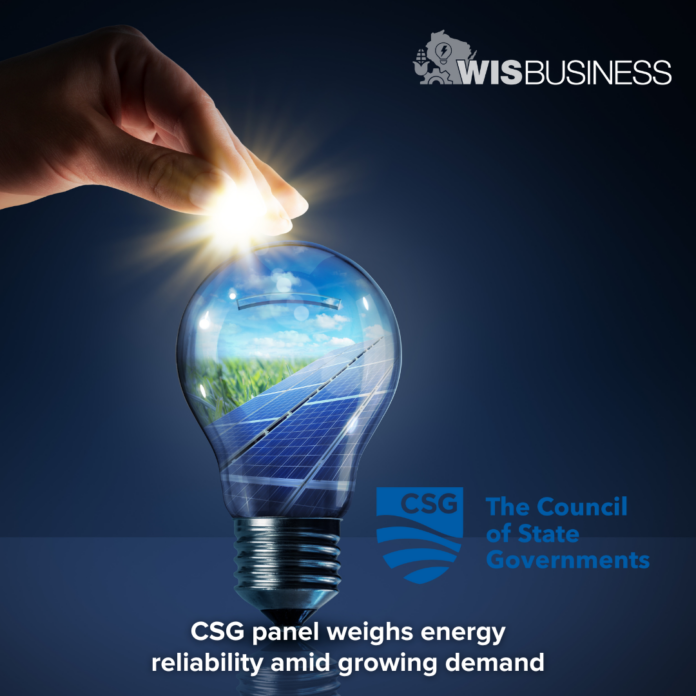By Mikel Livingston
Permitting reform and interagency communication at all levels are keys for state governments to accommodate rising energy needs, panelists told a collection of lawmakers in Ohio this week.
Rising load due to data centers and other energy-intensive users coming online was front and center during a recent panel of the Council of State Governments’ Midwestern Legislative Conference in Columbus.
The discussion over the region’s energy future centered on the balance state policymakers face in maintaining reliability in a complex area of policy that moderator Tony Clark acknowledged “can get weedy fast.” Clark is a senior adviser at D.C. communications firm Wilkinson Barker Knauer and a former member of the Federal Energy Regulatory Commission.
He attributed the rising demand in part to the ongoing “explosion” of data centers alongside resource retirements in part due to policies favoring carbon reduction.
Microsoft in May announced plans for building a $3.3 billion data center in southeastern Wisconsin’s Mount Pleasant by 2026, with a focus on cloud computing and AI. In its announcement, the Washington-based tech company said it will build a new 250 megawatt solar project in Wisconsin that would begin operating in 2027.
“Nationwide they’re saying something like 1% per year load growth,” Clark said of demand projections. “In reality, that’s a lot. It’s probably more than double what the demand increase has been year over year.”
Maria Haberman, vice president of external affairs for AEP Ohio, said the proliferation of those large users has given the utility another chance to engage with officials.
“It has given us an opportunity to educate our state leaders…what goes into planning the system,” she said.
J. Arnold Quinn, chief economist and senior vice president of regulatory policy for Texas-based energy company Vistra Corp., said lawmakers often do not realize the nature of generation is “one big soup.”
He encouraged lawmakers not to question whether they have enough generation in their state. “It’s, ‘Do I have enough generation in my market?’” he said.
He called demand growth an “opportunity to send a very clear investment signal that more generation is needed.”
“What we really need is regulatory certainty,” he said. “We don’t need a guarantee. We just need some sufficient level of confidence that the rules of the game are not going to be changed now that we’ve made a big investment.”
Reliability must remain at the “front and center,” said Todd Snitchler, president and CEO of the Electric Power Supply Association, based in Washington, D.C.
He called for an “honest conversation” about the need for more natural gas infrastructure and described an inherent tension between “aspirational policy goals and operational realities.”
“We can want to do a lot of things, but the laws of physics have never lost,” he said. “So we have to be thoughtful in considering how is this policy going to impact what can actually be achieved versus what it is that we would like to hope to do.”
Repeating an adage he commonly deployed during his time as chair of the Public Utilities Commission of Ohio, Snitchler said citizens want “their lights on, beer cold and water warm.”
Chris Ziegler, executive director of American Petroleum Institute-Ohio, attributed demand shifts to “good things” like reshoring manufacturing jobs, and increasing data centers and cryptocurrency mining facilities.
“All told, I think we can meet this challenge,” he said, going on to label natural gas the “best near-term option for power supply.”
“There are challenges with natural gas,” he said. “But the bottom line, we believe, is that natural gas can help us tackle the pending load growth issue with the right policies.”
The majority of the panelists bemoaned the speed of permitting at the federal level, with Haberman describing a “misalignment” between federal regulations and agencies like the international grid regulator North American Electric Reliability Corp. and the Federal Energy Regulatory Commission.
“Those organizations and agencies aren’t talking to each other,” she said.
Both she and Snitchler suggested lawmakers’ best move is to educate themselves and engage with those they can learn from in this complex policy space.
Snitchler urged lawmakers to engage with their state commissions, who have technical expertise and “want to help.”
“As legislators your best source of information is to engage with those folks…and share information as well,” he said.
Ziegler, who said that in the last decade 10 major infrastructure projects have been scuttled in the Appalachian region due to red tape, urged policymakers to pursue reforms while remaining fixed on an all-of-the-above approach.
“Everything needs to be thrown at this challenge, but not at the expense of other resources that brought us to this point,” he said.






